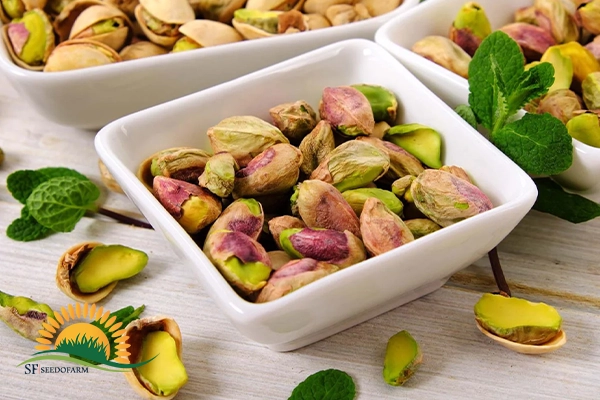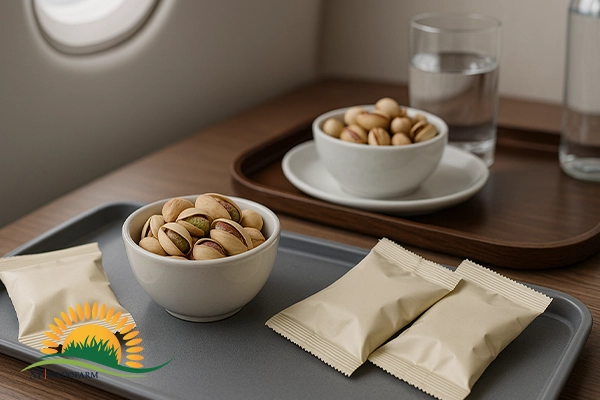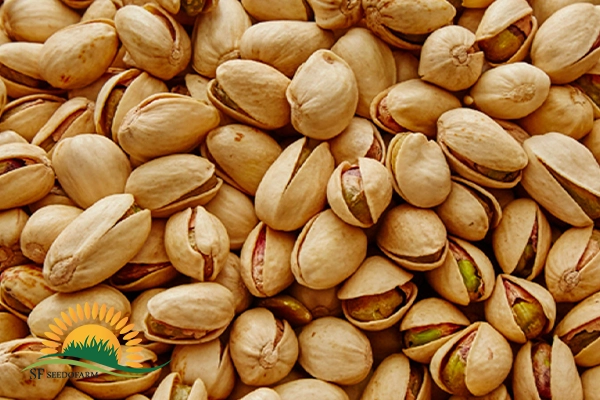A practical pistachio varieties comparison shows that Akbari (Super Long) offers elegant, elongated shells for premium gifting; Ahmad Aghaei (Long) balances presentation with reliable roasting for retail; Jumbo (Kalleh Ghouchi) delivers large, rounded nuts with a rich bite for impact on shelf; and Round pistachio (Fandoghi) provides the best value and kernel count for snacks and industrial use. Choosing between them depends on counts (pcs/oz), open-mouth ratio, moisture targets, flavor profile, and packaging goals.
Introduction: Why Variety Choice Matters
Selecting the right pistachio variety is not cosmetic. It shapes roasting performance, perceived value, and margin. Buyers in retail, foodservice, confectionery, and private label need a clear method to assess four Iranian lines: Akbari, Ahmad Aghaei, Jumbo, and Round.
This article provides a data-driven pistachio varieties comparison. We link counts per ounce, split ratio, kernel color, and moisture stability to real use cases such as premium gifting, everyday snacking, confectionery/ice cream inputs, and airline or hotel amenities.
You will also see where Akbari pistachio vs Ahmad Aghaei differs in shape, visual appeal, and roasting reliability—and how Jumbo pistachio vs Round pistachio balances size impact with cost-performance and kernel yield. The goal is simple: choose the right grade the first time, cut rework, and protect brand quality.

Quick Comparison Table (Buyer’s Snapshot)
| Variety | Typical Counts (pcs/oz) | Shell/Kernal Look | Flavor & Texture | Best For | Watch-outs |
|---|---|---|---|---|---|
| Akbari (Super Long) | 18–20, 20–22, 22–24 | Very long, elegant; deep green kernels | Naturally sweet, clean crunch | Premium retail, gifting, display packs | Price premium; ensure high split ratio |
| Ahmad Aghaei (Long) | 22–24, 24–26, 26–28 | Long and uniform; bright ivory shells | Sweet-buttery, reliable roast | Retail lines, private label, snacks | Calibrate roast to avoid over-drying tips |
| Jumbo (Kalleh Ghouchi) | 18–20, 20–22, 22–24 | Large, broad shells; generous split | Rich, nutty, hearty bite | Gift tins, premium snack impact | Higher unit weight → fewer pieces per kg |
| Round (Fandoghi) | 26–28, 28–30, 30–32, 32–34 | Compact, tidy shells; vivid kernels | Balanced sweetness, crisp | Value retail, industrial/confectionery | Control closed/empty shells via sorting |
How to read counts: lower counts (e.g., 18–20) are bigger nuts, higher counts (e.g., 30–32) are smaller nuts. Counts affect perceived value and price per kilogram.
How to Evaluate Pistachios (Method You Can Reuse)
A rigorous pistachio varieties comparison should apply the same checklist to every lot. Use this buyer-friendly method on samples and certificates:
1) Sizing and counts (pcs/oz)
- Confirm the declared range with a counted sample (≥100 nuts).
- Ensure the weight basis matches your supplier’s COA. Sizing consistency supports even roasting and predictable fill weights in retail pouches.
2) Open-mouth (split) ratio
- High split ratio improves visual appeal and consumer perception.
- For premium Akbari and Jumbo, a lower percentage of closed shells is essential; reject or downgrade if closed/empty shells exceed your tolerance.
3) Moisture target
- Aim for ≤5% for crisp texture and shelf stability.
- Uneven moisture drives uneven roast color and variable crunch. Request moisture readings on the COA and verify with your own quick check (oven or calibrated meter) on arrival.
4) Kernel color and integrity
- Look for deep green to green-yellow kernels with minimal bruising.
- In confectionery/ice cream, brighter kernels lift visual quality and reduce the need for artificial color correction.
5) Defects and foreign matter
- Use optical + manual inspection to control shell staining, insects, and broken shells.
- Agree on acceptable limits per 1,000 g (or per 1,000 nuts) and make them part of your PO.
6) Aflatoxin controls and food safety
- Require lot-level test results aligned with your destination’s legal limits.
- Expect HACCP-aligned handling and documented traceability from orchard to carton.
7) Roasting behavior and seasoning uptake
- Test a small batch at two roast curves (e.g., 145–155 °C ranges) and evaluate color, crunch, and oil pickup.
- Akbari vs Ahmad Aghaei: Ahmad Aghaei typically tolerates slightly more aggressive curves with even color; Akbari rewards precise control to protect tip color.
- Jumbo vs Round pistachio: Jumbo’s mass retains heat longer—watch for carryover. Round accepts a wide range of seasonings uniformly due to surface ratio.
8) Packaging and oxygen exposure
- For retail and longer transit times, specify oxygen-barrier pouches with nitrogen flush or vacuum for bulk.
- Add tamper-evident features and a clear “packed on / best before” scheme to support audits and consumer trust.
Akbari (Super Long) — Profile & Use Cases
Visual identity. Akbari is the “statement” pistachio: elongated shells, attractive open mouth, and deep green kernels that photograph beautifully in transparent packaging. In any pistachio varieties comparison, Akbari sets the premium benchmark for gifting and display packs.
Counts & grading. Common ranges are 18–20, 20–22, and 22–24 pcs/oz. Lower counts elevate perceived luxury but push price upward. Specify a high split ratio and strict limits on closed or empty shells to avoid consumer disappointment in premium lines.
Flavor & texture. Naturally sweet with a clean, crisp crunch when the moisture target is controlled at or below 5%. The elegant profile and crunch make Akbari ideal for dry roast + light salt or delicate lemon-salt where visual clarity matters.
Processing notes.
- Optical sorting plus final manual checks help minimize shell staining (more visible on elongated shells).
- Roast curves should be steady; avoid over-drying tips which can slightly darken.
Best uses.
- Premium gifting, seasonal tins, high-end retail pouches, and display jars.
- Pair with minimalist artwork and transparent windows to let the nuts sell themselves.
Procurement tip. In Akbari vs Ahmad Aghaei, choose Akbari when presentation is the primary goal and consumers will pay for aesthetics. Lock in split-ratio specs and ask for photography samples from the exact lot before confirming labels and print runs.

Ahmad Aghaei (Long) — Profile & Use Cases
Visual identity. Ahmad Aghaei maintains a long, tidy silhouette but is marginally less dramatic than Akbari—often with bright ivory shells that read “clean” on shelf. For many buyers, it balances upscale presentation with dependable processing.
Counts & grading. Typical counts are 22–24, 24–26, 26–28 pcs/oz. The distribution provides flexibility for mainstream retail SKUs and private-label programs, keeping costs predictable without sacrificing look.
Flavor & texture. Sweet-buttery notes and uniform crunch after roasting. This variety is forgiving across a range of roast temperatures, making it a favorite for regional roasters experimenting with spice blends.
Processing notes.
- Good seasoning uptake across dry and wet applications.
- Maintain moisture control to prevent surface over-drying; Ahmad Aghaei generally tolerates slightly faster curves than Akbari with even color development.
Best uses.
- Everyday premium retail, private-label lines, travel retail, and hotel amenities.
- Works well for mixed-nut assortments where shape uniformity still matters.
Procurement tip. In Akbari vs Ahmad Aghaei, select Ahmad Aghaei when you need consistent roasting performance and strong shelf appeal at sharper price points. It’s the “workhorse” long variety for national listings.
Jumbo (Kalleh Ghouchi) — Profile & Use Cases
Visual identity. Jumbo is instantly recognizable: broad, rounded shells with a generous split and full kernels that create strong shelf impact. In any pistachio varieties comparison, Jumbo signals abundance and indulgence—perfect for gift tins and premium snack lines where “bigger looks better.”
Counts & grading. Typical ranges include 18–20, 20–22, and 22–24 pcs/oz. Remember: the lower the count, the larger the nut—and the stronger the premium. Because of Jumbo’s mass, unit weight rises quickly, which translates into fewer visible pieces per kilogram in retail pouches. Plan SKU weights and price points accordingly.
Flavor & texture. Rich, nutty, and slightly buttery; the larger kernel retains moisture evenly and responds well to medium roasts. Consumers often perceive Jumbo as “meatier,” which helps justify premium pricing in special-occasion formats.
Processing notes.
- Calibrate roast time/temperature to account for carryover heat; large kernels may continue to darken slightly post-roast.
- Optical sorting is useful to control shell staining that is more noticeable on broad surfaces.
- Seasonings with particulates (e.g., chili flakes, herbs) adhere nicely to the bigger surface area.
Best uses.
- Premium gift tins, corporate gifting, and travel retail.
- Feature displays and hero images for e-commerce where visual scale enhances CTR.
Procurement tip. When weighing Jumbo vs Round pistachio, choose Jumbo for maximum perceived value and giftability. Align cost models to account for fewer pieces per pack and ensure your target consumer is willing to pay for the visual upgrade.
Round (Fandoghi) — Profile & Use Cases
Visual identity. Round pistachio offers a compact, symmetrical shape with tidy presentation. It is the most widely available Iranian line, making it the backbone of value and volume programs.
Counts & grading. Common ranges include 26–28, 28–30, 30–32, and 32–34 pcs/oz. The higher kernel count per kilogram makes Round a compelling choice for price-sensitive SKUs and industrial buyers who need predictable yield.
Flavor & texture. Balanced sweetness with a crisp bite when moisture is maintained at or below 5%. Round roasts evenly and accepts seasoning uniformly, making it extremely versatile.
Processing notes.
- Because it is used heavily in snacks and as an ingredient, focus QA on closed/empty shell reduction and foreign matter control.
- The compact shell is forgiving in high-throughput roasters and continuous lines.
Best uses.
- Everyday snacking, convenience retail, multi-pack formats.
- Confectionery (nougat, brittle), bakery, and ice cream due to strong kernel yield.
Procurement tip. In Jumbo vs Round pistachio, choose Round when cost-performance and ingredient yield are the top priorities. Specify strict tolerances for defects to protect throughput and reduce rework.
Pricing & Yield Economics (What Buyers Actually Pay For)
A practical pistachio varieties comparison must link visual attributes to economics:
- Counts drive price and perceived value.
Lower counts (larger nuts) command higher prices per kilogram. They also reduce piece count per retail pouch, so ensure your pack weights and margins remain competitive. - Kernel yield matters for industry.
In ingredient applications, kernel yield per kilogram is the key driver. Round typically wins here due to smaller size and higher piece count, which can lower the cost per portion in confectionery and ice cream. - Split ratio affects consumer satisfaction.
Closed or empty shells create returns and negative reviews. Premium formats (Akbari, Jumbo) must have tight limits, even if that nudges the price upward. - Defect and staining control save money downstream.
Cleaner lots reduce labor at the roaster and speed up line changeovers. What looks like a slightly higher purchase price can be a net saving after labor and waste are accounted for. - Packaging choices impact landed cost.
Oxygen-barrier pouches, nitrogen flush, and tamper-evident features increase unit cost but reduce stale returns. For long routes or seasonal gifting, this trade-off is usually positive.
Rule of thumb: If your brand story depends on presentation—choose Akbari or Jumbo and budget for higher counts. If your P&L depends on throughput and recipe yield—Round or mid-count Ahmad Aghaei gives the best balance.

Roasting, Seasoning & Moisture Management
Roasting converts good raw nuts into great finished products. The differences between varieties are subtle but important:
- Target moisture: Keep finished products at ≤5%. This threshold supports crisp texture and slows rancidity.
- Akbari: Use steady, slightly gentler curves to protect tip color on the long shell. Dry roast + light salt or lemon-salt preserves elegance.
- Ahmad Aghaei: Highly forgiving; supports a range of curves and spice coatings. Good option for private label where multiple seasoning SKUs share a line.
- Jumbo: Account for carryover heat—cool actively to prevent over-coloration. Larger surface area holds dry spices attractively.
- Round: Accepts a wide array of seasonings and wet applications thanks to even shape and surface ratio; ideal for high-volume flavored lines.
Process controls to standardize flavor and crunch:
- Pre-roast moisture equalization (resting) to minimize variance.
- In-process thermocouple checks at multiple points in the bed.
- Post-roast cooling with forced air before sealing to reduce condensation risk.
When evaluating a supplier for your pistachio varieties comparison, request small roasted samples at two curve profiles and choose the one that balances color, crunch, and seasoning uptake for your market.
Packaging & Shelf Life (Protecting Value in Transit)
Packaging is where quality wins or loses during shipping and retail display:
- Retail pouches (150 g–1 kg): Specify multilayer oxygen-barrier film with nitrogen flush to lock in flavor and color. Add a zip for resealability and a “packed on / best before” window.
- Foodservice (5 kg): Vacuum bags in outer cartons maintain freshness and suit cafés, hotels, and airline catering.
- Bulk export (10 kg in 20–25 kg masters): Vacuum bags with reinforced cartons help containerized shipments withstand stacking and humidity changes.
Shelf life guidance:
- Under cool, dry storage away from light: up to 12 months from packing.
- For extended programs or hot climates, refrigeration/freezer storage improves stability.
- Add tamper-evident features for retail trust and compliance.
Quality Assurance & Compliance
A credible pistachio varieties comparison also covers what auditors will check:
- Traceability: Lot-level documentation from orchard to master carton.
- HACCP alignment: Documented CCPs around sorting, roasting, and packing.
- Aflatoxin verification: Certificates aligned with the destination market’s legal limits.
- Physical parameters: Counts, open-mouth ratio, moisture, defects per standard sample size.
- Sensory checks: Color, aroma, taste, and crunch recorded by trained panelists.
- Labeling compliance: Origin, net weight, nutrition panel (as required), storage, and best-before date.
Build these requirements into your PO and vendor agreements. Consistent paperwork protects your brand and speeds customs clearance.
Decision Guide: Which Variety Fits Your Market?
Use this quick guide to connect variety to audience and channel. It distills the pistachio varieties comparison into an action table:
- Luxury retail & gifting: Choose Akbari (low counts) or Jumbo. Prioritize split ratio, spotless shells, and transparent packaging.
- Mainstream retail/private label: Choose Ahmad Aghaei at mid counts (24–26 or 26–28) for dependable roasting and strong shelf appeal.
- Value retail & convenience: Choose Round at higher counts (30–32, 32–34) to optimize price points without compromising crunch.
- Confectionery/ice cream/bakery: Choose Round kernels (and whole nuts when visual pieces are needed) for predictable yield and color.
- Travel retail & corporate gifting: Choose Jumbo for showstopping visuals, or Akbari for elegance in tins and glass jars.
If you run multiple SKUs, a tiered strategy works well: Round for entry price points, Ahmad Aghaei for everyday premium, and Akbari/Jumbo for gifting.
Conclusion & Contact
A clear pistachio varieties comparison links the look and behavior of each variety to business outcomes. Akbari delivers elegance for premium gifting, Ahmad Aghaei balances presentation with roasting reliability for everyday premium, Jumbo creates high-impact visuals for special formats, and Round pistachio maximizes value and yield for snacks and industrial use.
If you’re planning retail, private-label, foodservice, or bulk programs, we can provide detailed specifications, samples, and pack options tailored to your market.
How to source from Seedo Farm: We do not sell directly online. Please submit your inquiry via the Contact page with your target counts, grades, packaging format, and monthly volume—our team will respond with availability, lead times, and a tailored quotation.
FAQ (Buyer-Focused):
1) What counts per ounce should I specify for premium gifting?
For immediate visual impact, 18–20 or 20–22 in Akbari or Jumbo. Include strict split-ratio limits and a moisture target of ≤5% in your PO.
2) Which variety is best for aggressive spice blends?
Ahmad Aghaei and Round handle a wide range of curves and seasonings with uniform color and texture. They’re reliable for multi-SKU private labels.
3) How do counts affect my retail margin?
Lower counts mean larger nuts and higher cost per kilogram. You’ll show fewer pieces per pouch; price positioning and storytelling must justify the premium.
4) What moisture level should I aim for after roasting?
Keep finished products at ≤5% to preserve crunch and slow oxidation. Verify with your own meter and include targets in supplier documentation.
5) What defects should I watch most closely?
Closed/empty shells, shell staining, and foreign matter. Agree on limits per sample size and back them with optical + manual inspection.



